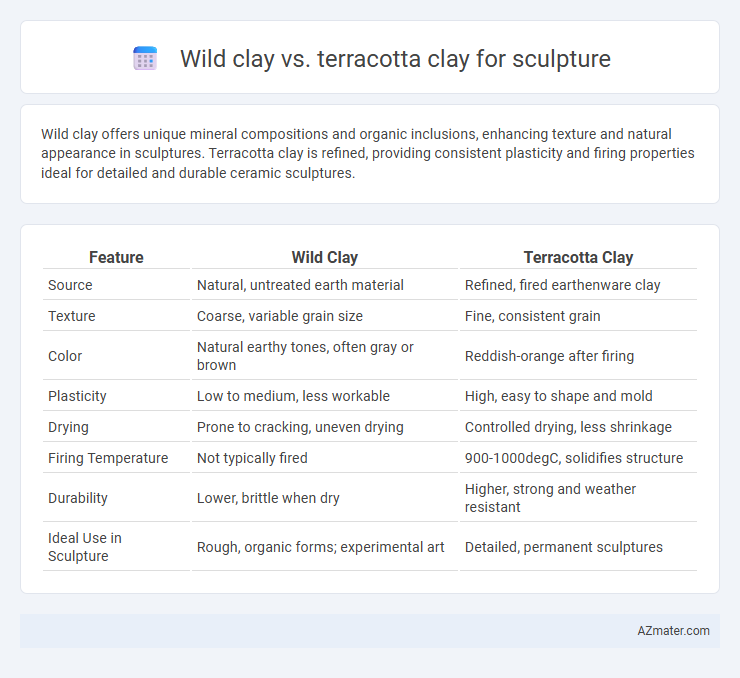Wild clay offers unique mineral compositions and organic inclusions, enhancing texture and natural appearance in sculptures. Terracotta clay is refined, providing consistent plasticity and firing properties ideal for detailed and durable ceramic sculptures.
Table of Comparison
| Feature | Wild Clay | Terracotta Clay |
|---|---|---|
| Source | Natural, untreated earth material | Refined, fired earthenware clay |
| Texture | Coarse, variable grain size | Fine, consistent grain |
| Color | Natural earthy tones, often gray or brown | Reddish-orange after firing |
| Plasticity | Low to medium, less workable | High, easy to shape and mold |
| Drying | Prone to cracking, uneven drying | Controlled drying, less shrinkage |
| Firing Temperature | Not typically fired | 900-1000degC, solidifies structure |
| Durability | Lower, brittle when dry | Higher, strong and weather resistant |
| Ideal Use in Sculpture | Rough, organic forms; experimental art | Detailed, permanent sculptures |
Understanding Wild Clay and Terracotta Clay
Wild clay, often sourced directly from natural landscapes, contains organic materials and minerals that influence its texture and firing properties, making it less processed and variable in composition. Terracotta clay is a refined, porous earthenware clay known for its reddish-brown color due to high iron content and is widely favored in sculpture for its consistent firing behavior and durability. Sculptors choose wild clay for its raw, textured finish and organic appearance, while terracotta clay offers reliability, ease of use, and a traditional aesthetic in ceramic art.
Origins and Composition of Wild Clay
Wild clay originates from natural deposits typically found near riverbanks, forests, or volcanic regions, characterized by its unrefined, organic composition rich in minerals and impurities. Its mineral content varies widely due to diverse environmental factors, resulting in a texture that is often coarser and more variable than terracotta clay. Terracotta clay, in contrast, is a processed, purified form of clay known for its consistent fine grain and iron-rich composition, ideal for traditional sculpting and pottery.
The Processing of Terracotta Clay
Terracotta clay undergoes a meticulous process of refining and wedging to eliminate impurities and ensure uniform consistency, making it ideal for detailed sculptures. This clay is typically mixed with water to achieve plasticity, then shaped before being air-dried and fired at lower temperatures between 1000degC and 1150degC, resulting in its characteristic porous and reddish appearance. In contrast, wild clay is often unrefined and gritty, demanding less processing but offering limited control over texture and strength in sculptural works.
Workability: Texture and Plasticity Compared
Wild clay typically exhibits a coarser texture with variable plasticity, impacting the ease of detailed sculpting and fine surface finishes. Terracotta clay, known for its smoother texture and higher plasticity, allows for greater manipulation and consistent shaping, making it ideal for intricate and refined sculptures. Artists often prefer terracotta for projects requiring delicate detail and uniformity, while wild clay suits pieces where rustic, natural textures are desired.
Color Variations and Firing Results
Wild clay often contains natural impurities and minerals, resulting in varied color tones from earthy reds and browns to grayish hues depending on the source. Terracotta clay tends to have a consistent iron oxide content, producing warm reddish-orange colors when fired at lower temperatures around 1000-1100degC. Firing wild clay may yield unpredictable finishes with richer textures, while terracotta offers reliable, vibrant coloration and good porosity for sculpture stability.
Strength and Durability in Sculptural Use
Wild clay typically offers higher plasticity and strength, making it suitable for detailed sculptural work that requires durability. Terracotta clay, while often more porous and less dense after firing, provides good resilience and a distinctive warm color but may be more prone to chipping and cracking under stress. Sculptors seeking long-lasting pieces often prefer wild clay for its superior structural integrity and resistance to environmental wear.
Availability and Cost Factors
Wild clay, often sourced locally from natural deposits, tends to be more readily available in rural or undeveloped areas and usually incurs lower costs due to minimal processing requirements. Terracotta clay, widely distributed through commercial suppliers, offers consistent quality but generally comes at a higher price point because of its refinement and kiln-firing preparation. Sculptors prioritize wild clay for budget-friendly, accessible projects, while terracotta clay is preferred for detailed, durable sculptures despite its increased material expense.
Environmental Impact of Harvesting Each Clay
Wild clay harvesting often involves minimal environmental disruption as it is collected from naturally exposed deposits, reducing the need for extensive excavation. Terracotta clay extraction typically requires more intensive mining and land alteration, potentially leading to habitat disturbance and increased soil erosion. Sustainable practices in sourcing both clays, such as regulated extraction and site rehabilitation, are essential to mitigate their environmental impact in sculpture production.
Artistic Applications: Surface Treatments and Finishes
Wild clay offers a textured, natural surface ideal for rustic and organic sculptures, enhancing tactile appeal through minimal processing. Terracotta clay provides a smooth, consistent texture that is well-suited for detailed surface treatments such as carving, glazing, and polishing, allowing artists to achieve refined finishes and rich color variations. Both clays support diverse finishing techniques, but terracotta's fired durability enables long-lasting preservation of intricate patterns and vibrant surface embellishments.
Choosing the Right Clay for Your Sculpture Project
Choosing the right clay for sculpture involves understanding key differences between wild clay and terracotta clay. Wild clay, often sourced from natural environments, contains varied minerals and organic matter, providing unique textures but requiring thorough processing to ensure durability. Terracotta clay, a refined earthenware clay, offers consistent plasticity and is ideal for firing at moderate temperatures, resulting in a sturdy, reddish-brown finish perfect for detailed sculptural work.

Infographic: Wild clay vs Terracotta clay for Sculpture
 azmater.com
azmater.com